Cisco ASA¶
Table of Contents¶
Release Notes¶
Version |
Date |
Notes |
|---|---|---|
1.2.0 |
09/2023 |
Convert to playbooks |
1.1.0 |
06/2022 |
Update payload samples |
1.0.0 |
04/2021 |
Initial Release |
1.2.0 Changes¶
In v1.2, the existing rules and workflows have been replaced with playbooks. This change is made to support the ongoing, newer capabilities of playbooks. Each playbook has the same functionality as the previous, corresponding rule/workflow.
If upgrading from a previous release, notice that the previous release’s rules/workflows remain in place. Both sets of rules and playbooks are active. For manual actions, playbooks will have the same name as it’s corresponding rule, but with (PB) added at the end.
You can continue to use the rules/workflows, but migrating to playbooks provides greater functionality along with future app enhancements and bug fixes.
Starting with the 1.2.0 release, the Cisco ASA app no longer loads the Cisco ASA Firewall Network Object Group select field values at app startup and the network_object_groups parameter is removed from the app.config file. You must edit the playbook activation form for playbooks that use a select list for Firewall / Network Object Group pairing input selection.
See section Add Firewall Network Object Group pairs to Activation form for more detail.
Overview¶
IBM SOAR app for Cisco ASA
IBM SOAR integration with Cisco ASA - Adaptive Security Appliance. Manage Cisco ASA network objects from SOAR.
Key Features¶
Key capabilities include the following:
Allows a SOC analyst to pre-configure available firewalls with credentials in the app.config file. Each firewall contains a list of Cisco ASA named network object groups for blocking inbound traffic and outbound traffic, also specified in the app.config.
Provides the ability to display all IP addresses currently in a network object group blocklist in a data table.
Provides the ability to add IP address to the blocklist (network object group).
Provides the ability to remove an IP addresses from blocklist (network object group).
The following IP network objects are can be added/removed from a network object group:
IPv4Address
IPv4Range
IPv4Network
IPv4FQDN
IPv6Address
IPv6Range
IPv6Network
IPv6FQDN
Requirements¶
This app supports the IBM Security QRadar SOAR Platform and the IBM Security QRadar SOAR for IBM Cloud Pak for Security.
SOAR platform¶
The SOAR platform supports two app deployment mechanisms, Edge Gateway (also known as App Host) and integration server.
If deploying to a SOAR platform with an Edge Gateway, the requirements are:
SOAR platform >=
46.0.8131.The app is in a container-based format (available from the AppExchange as a
zipfile).
If deploying to a SOAR platform with an integration server, the requirements are:
SOAR platform >=
46.0.8131.The app is in the older integration format (available from the AppExchange as a
zipfile which contains atar.gzfile).Integration server is running
resilient-circuits>=48.0.0.If using an API key account, make sure the account provides the following minimum permissions:
Name
Permissions
Org Data
Read
Org Data
Edit
Function
Read
Incidents
Read
Edit Incidents
Fields
The following SOAR platform guides provide additional information:
Edge Gateway Deployment Guide or App Host Deployment Guide: provides installation, configuration, and troubleshooting information, including proxy server settings.
Integration Server Guide: provides installation, configuration, and troubleshooting information, including proxy server settings.
System Administrator Guide: provides the procedure to install, configure and deploy apps.
The above guides are available on the IBM Documentation website at ibm.biz/soar-docs. On this web page, select your SOAR platform version. On the follow-on page, you can find the Edge Gateway Deployment Guide, App Host Deployment Guide, or Integration Server Guide by expanding Apps in the Table of Contents pane. The System Administrator Guide is available by expanding System Administrator.
Cloud Pak for Security¶
If you are deploying to IBM Cloud Pak for Security, the requirements are:
IBM Cloud Pak for Security >=
1.8.Cloud Pak is configured with an Edge Gateway.
The app is in a container-based format (available from the AppExchange as a
zipfile).
The following Cloud Pak guides provide additional information:
Edge Gateway Deployment Guide or App Host Deployment Guide: provides installation, configuration, and troubleshooting information, including proxy server settings. From the Table of Contents, select Case Management and Orchestration & Automation > Orchestration and Automation Apps.
System Administrator Guide: provides information to install, configure, and deploy apps. From the IBM Cloud Pak for Security IBM Documentation table of contents, select Case Management and Orchestration & Automation > System administrator.
These guides are available on the IBM Documentation website at ibm.biz/cp4s-docs. From this web page, select your IBM Cloud Pak for Security version. From the version-specific IBM Documentation page, select Case Management and Orchestration & Automation.
Proxy Server¶
The app does support a proxy server.
Python Environment¶
Python 3.6 and Python 3.9 are supported. Additional package dependencies may exist for each of these packages:
resilient-circuits>=48.0.0
Cisco ASA Development Version¶
This app has been implemented using: This app has been implemented using:
Product Name |
Product Version |
API URL |
API Version |
|---|---|---|---|
Cisco ASAv |
9.14(1) |
https://host |
N/A |
Installation¶
Install¶
To install or uninstall an App or Integration on the SOAR platform, see the documentation at ibm.biz/soar-docs.
To install or uninstall an App on IBM Cloud Pak for Security, see the documentation at ibm.biz/cp4s-docs and follow the instructions above to navigate to Orchestration and Automation.
App Configuration¶
The following table provides the settings you need to configure the app. These settings are made in the app.config file. See the documentation discussed in the Requirements section for the procedure.
The app.config file for this app contains a high level section denoted by [fn_cisco_asa] and subsections for each firewall denoted as [fn_cisco_asa:firewall_name], where each firewall_name is unique.
The table below provides the optional high level default settings. The credentials defined in this section are the default credentials used if the credentials are not defined in the individual firewall subsection.
Config |
Required |
Example |
Description |
|---|---|---|---|
username |
No |
|
Username of the Cisco ASA firewall |
password |
No |
|
Password of the Cisco ASA firewall. |
https_proxy |
No |
|
- |
http_proxy |
No |
|
- |
Config |
Required |
Example |
Description |
|---|---|---|---|
host |
Yes |
|
IP Address of the Cisco ASA firewall. |
username |
No |
|
Username of the Cisco ASA firewall |
password |
No |
|
Password of the Cisco ASA firewall. |
cafile |
No |
- |
Path to certificate file. |
Custom Layouts¶
Import the Cisco ASA Network Objects Data Tables and drag it onto a Cisco ASA Incident tab as shown in the screenshot below:
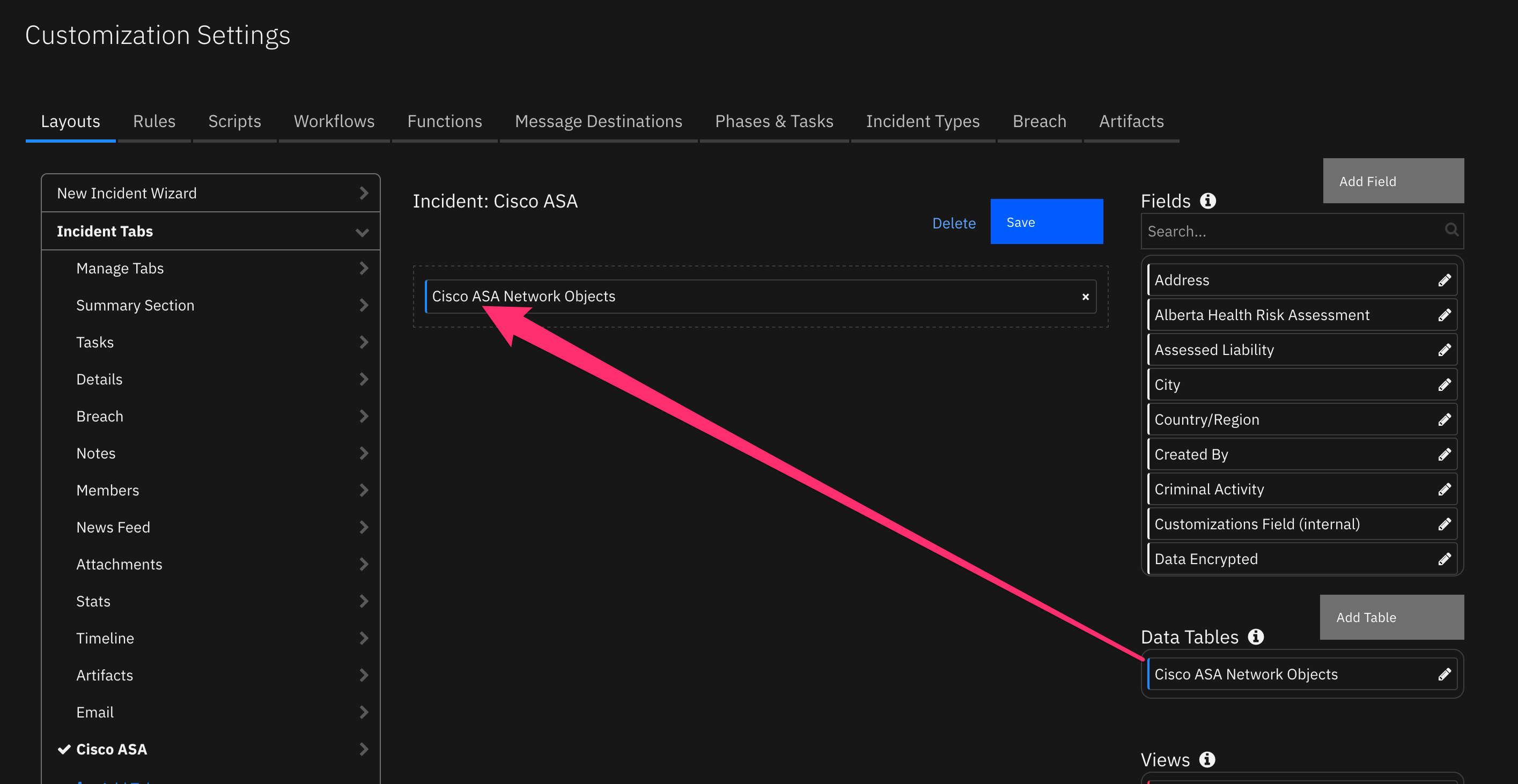
Cisco ASA Configuration¶
Install and Configure ASA REST API Agent and Client¶
To run the Cisco ASA app, you must first install and configure the Cisco ASA REST API Agent and Client on each device as described in the Cisco ASA REST API Quick Start Guide.
Create Cisco ASA Network Object Groups¶
The network object groups defined in the app.config are created by a user before running the app. The Cisco ASA CLI (command line interface) or the ASDM (Cisco Adaptive Security Device Manager - GUI interface) can be used to create the network object groups.
Here is an example configuration to create a network object group called BLOCKLIST_IN using the CLI:
hostname(config)# object-group network BLOCKLIST_IN
hostname(config-network)# network-object host 192.168.10.1
hostname(config-network)# network-object host 192.168.10.2
hostname(config-network)# network-object host 192.168.10.3
hostname(config-network)# access-list my-internet-access deny ip object-group BLOCKLIST_IN any
hostname(config)# access-list my-internet-access permit ip any any
hostname(config)# access-group my-internet-access in interface inside
The app makes REST API calls to add and remove network objects from the BLOCKLIST_IN network object group.
Add Firewall Network Object Group pairs to Activation form¶
To add your firewall and network object group select values make a copy of the playbooks that use the cisco_asa_firewall_network_object_group select list and add your firewall:network_object_group pairs to the list of values as shown in the red box in the screenshot below.
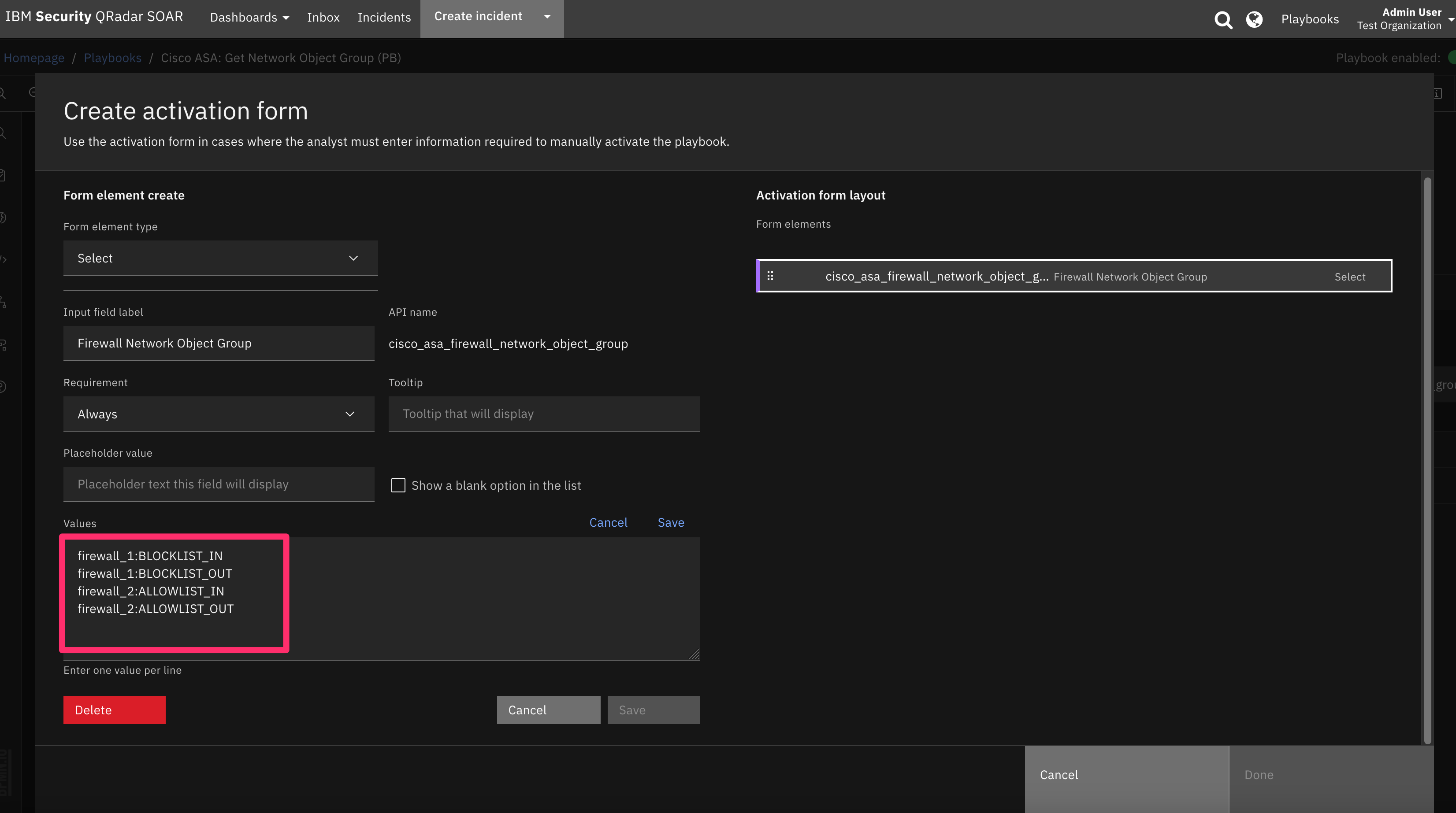
NOTE: if you edit the playbooks shipped with the app your playbook may be overwritten with future upgrades, therefore making a copy is recommended.
Function - Cisco ASA Add Artifact to Network Object Group¶
Add an artifact to a Cisco ASA network object group.
NOTE: Objects must have unique names that are limited to 64 characters, including letters and numbers. Space and these special characters: .!@#$%^&()-_{} are NOT permitted. Object names are case-sensitive.
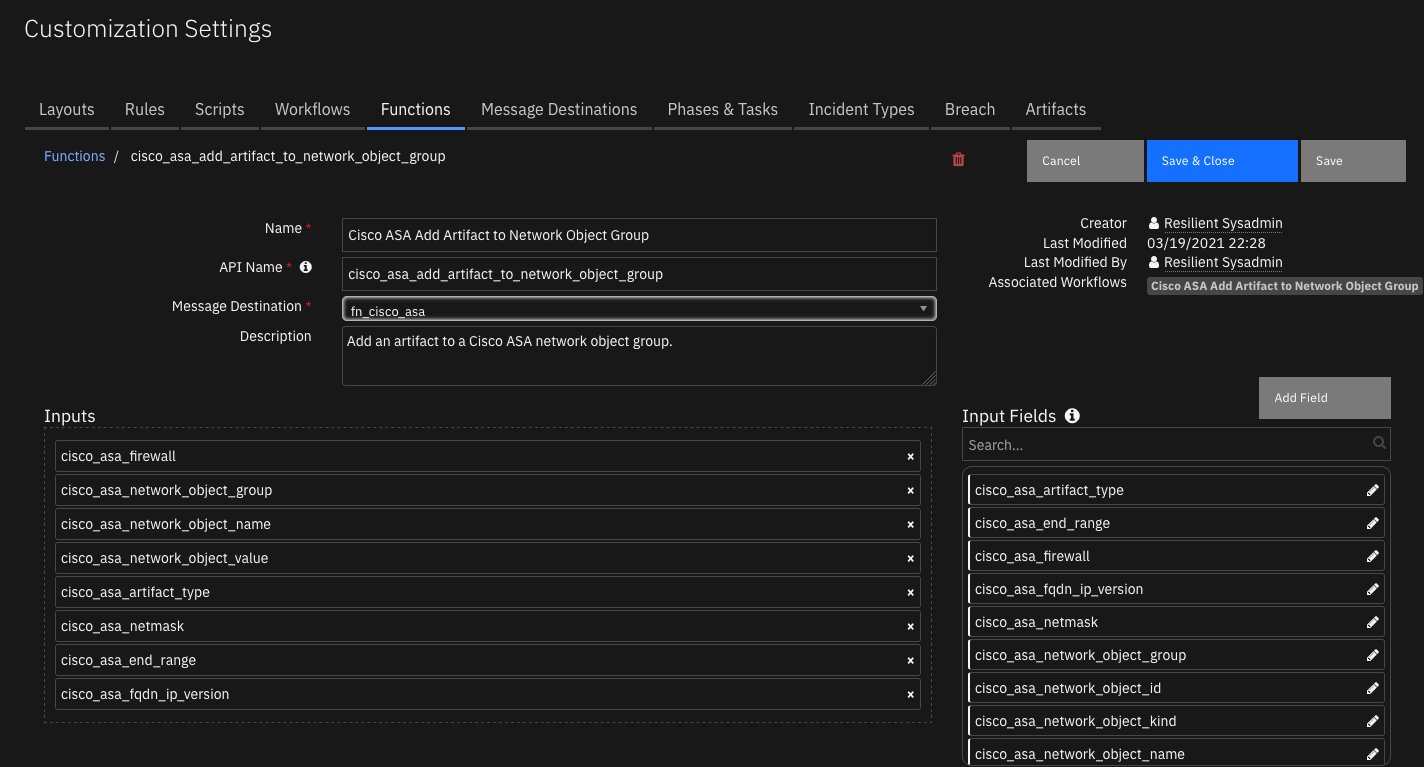
Inputs:
Name |
Type |
Required |
Example |
Tooltip |
|---|---|---|---|---|
|
|
Yes |
|
- |
|
|
No |
|
- |
|
|
Yes |
|
- |
|
|
No |
|
- |
|
|
No |
|
- |
|
|
No |
|
- |
|
|
Yes |
|
- |
|
|
No |
|
- |
|
|
Yes |
|
- |
Outputs:
NOTE: This example might be in JSON format, but
resultsis a Python Dictionary on the SOAR platform.
results = {
"content": {
"firewall": "firewall_1",
"network_object_description": "fqdn name",
"network_object_group": "BLOCKLIST_IN",
"network_object_kind": "IPv4FQDN",
"network_object_name": "MyFqdn",
"network_object_value": "www.fqdn.com",
"reason": "Object Kind: IPv4FQDN, Object Value: www.fqdn.com, Object Name: MyFqdn, is added to Firewall: firewall_1, Group: BLOCKLIST_IN"
},
"inputs": {
"cisco_asa_artifact_type": "DNS Name",
"cisco_asa_end_range": null,
"cisco_asa_firewall": "firewall_1",
"cisco_asa_fqdn_ip_version": {
"id": 427,
"name": "IPv4FQDN"
},
"cisco_asa_network_object_description": "fqdn name",
"cisco_asa_network_object_group": "BLOCKLIST_IN",
"cisco_asa_network_object_name": "MyFqdn",
"cisco_asa_network_object_value": "www.fqdn.com"
},
"metrics": {
"execution_time_ms": 696,
"host": "My-MacBook-Pro.local",
"package": "fn-cisco-asa",
"package_version": "1.0.0",
"timestamp": "2022-06-24 12:30:41",
"version": "1.0"
},
"raw": "{\"firewall\": \"firewall_1\", \"network_object_group\": \"BLOCKLIST_IN\", \"network_object_name\": \"MyFqdn\", \"network_object_description\": \"fqdn name\", \"network_object_kind\": \"IPv4FQDN\", \"network_object_value\": \"www.fqdn.com\", \"reason\": \"Object Kind: IPv4FQDN, Object Value: www.fqdn.com, Object Name: MyFqdn, is added to Firewall: firewall_1, Group: BLOCKLIST_IN\"}",
"reason": null,
"success": true,
"version": "1.0"
}
Example Function Input Script:
# Parse the firewall name and network object group from the colon separated string
firewall_group_pair = playbook.inputs.cisco_asa_firewall_network_object_group
# Parse the firewall group pair, which is a string in "firewall:network_object_group" format
firewall_group_pair_list = firewall_group_pair.split(":")
inputs.cisco_asa_firewall = firewall_group_pair_list[0]
inputs.cisco_asa_network_object_group = firewall_group_pair_list[1]
# Get input from the artifact type and value
inputs.cisco_asa_network_object_value = artifact.value
inputs.cisco_asa_artifact_type = artifact.type
# Optional network object description and object name
if playbook.inputs.cisco_asa_network_object_description:
inputs.cisco_asa_network_object_description = playbook.inputs.cisco_asa_network_object_description
if playbook.inputs.cisco_asa_network_object_name:
inputs.cisco_asa_network_object_name = playbook.inputs.cisco_asa_network_object_name
if playbook.inputs.cisco_asa_ipv4_netmask:
inputs.cisco_asa_netmask = playbook.inputs.cisco_asa_ipv4_netmask
Example Function Post Process Script:
from datetime import datetime
results = playbook.functions.results.add_artifact_results
success = results.get("success")
content = results.get("content")
firewall = content.get("firewall")
network_object_group = content.get("network_object_group")
network_object_value = content.get("network_object_value")
network_object_name = content.get("network_object_name")
network_object_kind = content.get("network_object_kind")
if success:
network_object_description = content.get("network_object_description")
# Add network object as a row in the network Cisco ASA network objects data table
network_object_row = incident.addRow("cisco_asa_network_object_dt")
network_object_row.cisco_asa_query_date = datetime.now()
network_object_row.cisco_asa_firewall = firewall
network_object_row.cisco_asa_network_object_group = network_object_group
network_object_row.cisco_asa_network_object_kind = network_object_kind
network_object_row.cisco_asa_network_object_value = network_object_value
network_object_row.cisco_asa_network_object_id = network_object_name
network_object_row.cisco_asa_network_object_description = network_object_description
# Update status field
status_text = u"""<p style= "color:{color}">{status}</p>""".format(color="green", status="Active")
network_object_row.cisco_asa_status = helper.createRichText(status_text)
else:
# Artifact not added to the group so add a note with the reason.
reason = content.get("reason")
note = u"Cisco ASA Add Artifact to Network Object Group Results:\n Artifact value: {0}\n Object Name: {1} \n Object Kind: {2} was not added to Firewall: {3}, Network Object Group: {4}\n\n{5}"
note = note.format(network_object_value, network_object_name, network_object_kind, firewall, network_object_group, reason)
incident.addNote(helper.createPlainText(note))
Function - Cisco ASA Get Network Object Details¶
Get the details of the Cisco ASA network object.
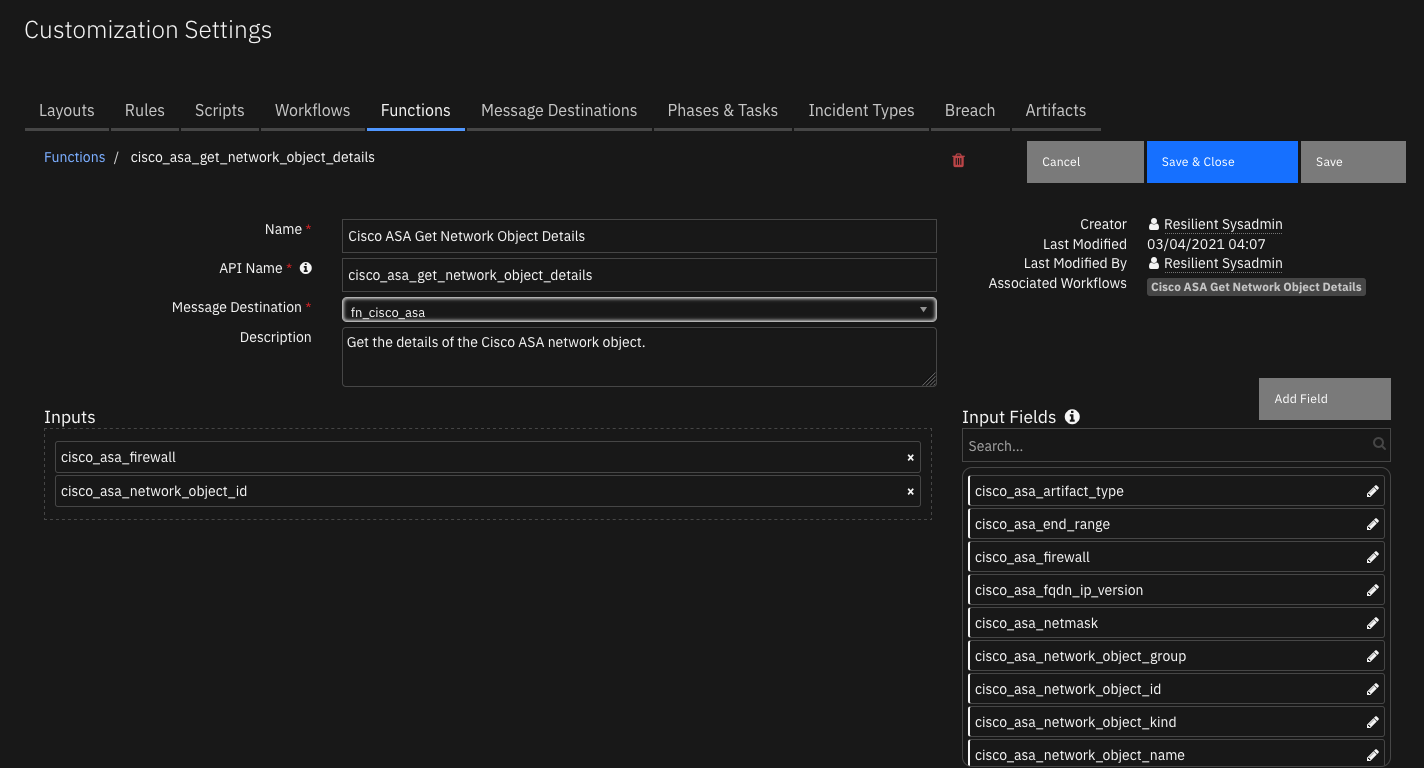
Inputs:
Name |
Type |
Required |
Example |
Tooltip |
|---|---|---|---|---|
|
|
Yes |
|
- |
|
|
No |
|
- |
Outputs:
NOTE: This example might be in JSON format, but
resultsis a Python Dictionary on the SOAR platform.
results = {
"content": {
"description": "fqdn name",
"host": {
"kind": "IPv4FQDN",
"value": "www.fqdn.com"
},
"kind": "object#NetworkObj",
"name": "MyFqdn",
"objectId": "MyFqdn",
"selfLink": "https://192.168.1.163/api/objects/networkobjects/MyFqdn"
},
"inputs": {
"cisco_asa_firewall": "firewall_1",
"cisco_asa_network_object_id": "MyFqdn"
},
"metrics": {
"execution_time_ms": 69,
"host": "MacBook-Pro.local",
"package": "fn-cisco-asa",
"package_version": "1.0.0",
"timestamp": "2022-06-24 12:30:59",
"version": "1.0"
},
"raw": "{\"kind\": \"object#NetworkObj\", \"selfLink\": \"https://192.168.1.163/api/objects/networkobjects/MyFqdn\", \"name\": \"MyFqdn\", \"host\": {\"kind\": \"IPv4FQDN\", \"value\": \"www.fqdn.com\"}, \"description\": \"fqdn name\", \"objectId\": \"MyFqdn\"}",
"reason": null,
"success": true,
"version": "1.0"
}
Example Function Input Script:
inputs.cisco_asa_firewall = row.cisco_asa_firewall
inputs.cisco_asa_network_object_id = row.cisco_asa_network_object_id
Example Function Post Process Script:
# Put the results json into a workflow property so we can call the
# convert_json_to_rich_text script to print readable formatted json in an incident note.
results = playbook.functions.results.get_details_results
inputs = results.get("inputs")
firewall_id = inputs.get("cisco_asa_firewall")
object_id = inputs.get("cisco_asa_network_object_id")
header = u"Cisco ASA Firewall: {0} Network Object ID {1}".format(firewall_id, object_id)
json_note = {
"version": "1.3",
"header": header,
"json": results.content,
"sort": False
}
playbook.addProperty('convert_json_to_rich_text', json_note)
Function - Cisco ASA Get Network Objects¶
Query the Cisco ASA firewall and return the network objects contained in the specified network object group.
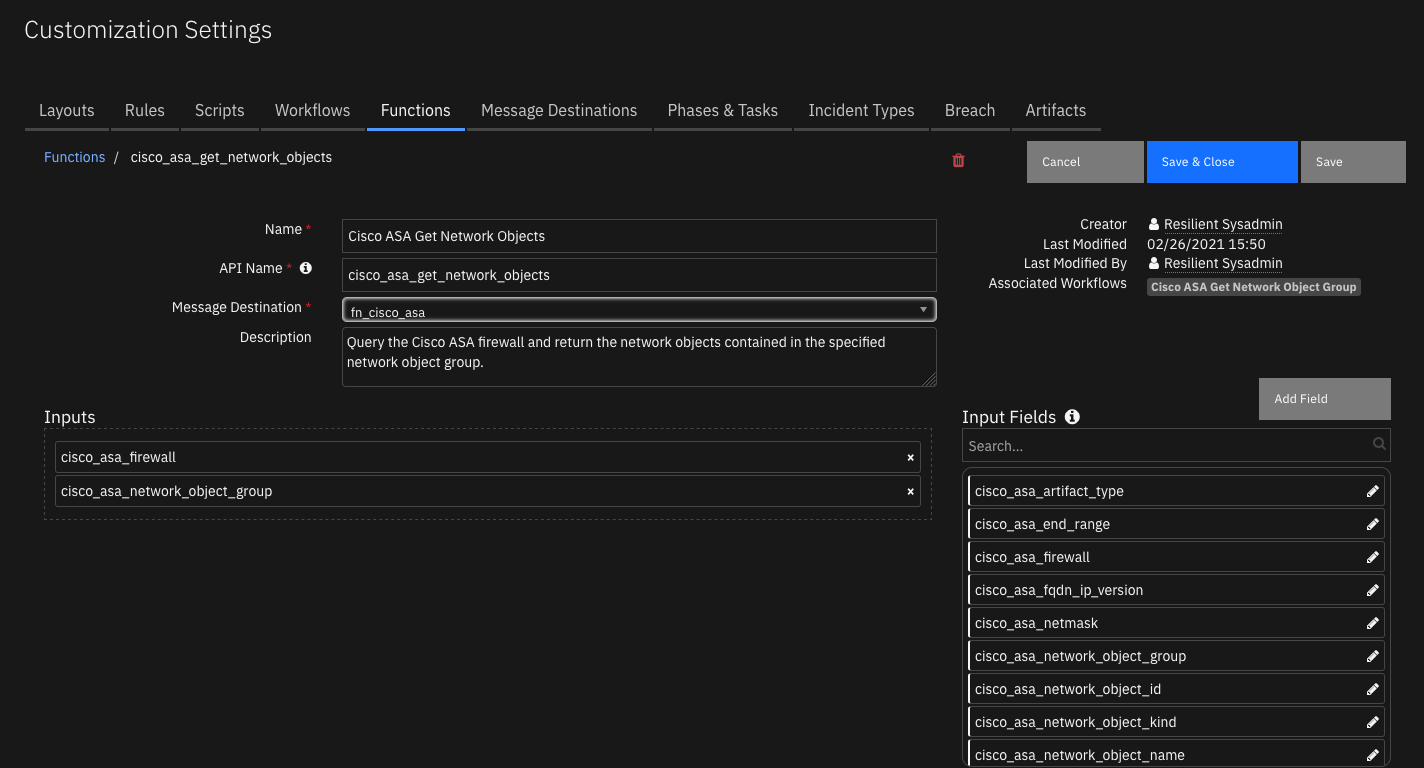
Inputs:
Name |
Type |
Required |
Example |
Tooltip |
|---|---|---|---|---|
|
|
Yes |
|
- |
|
|
Yes |
|
- |
Outputs:
NOTE: This example might be in JSON format, but
resultsis a Python Dictionary on the SOAR platform.
results = {
"content": {
"member_list": [
{
"kind": "IPv4Address",
"value": "192.168.10.1"
},
{
"kind": "IPv4Address",
"value": "192.168.10.2"
},
{
"kind": "IPv4Address",
"value": "192.168.10.3"
}
]
},
"inputs": {
"cisco_asa_firewall": "firewall_1",
"cisco_asa_network_object_group": "BLOCKLIST_IN"
},
"metrics": {
"execution_time_ms": 551,
"host": "MacBook-Pro.local",
"package": "fn-cisco-asa",
"package_version": "1.0.0",
"timestamp": "2022-06-24 12:23:40",
"version": "1.0"
},
"raw": "{\"member_list\": [{\"kind\": \"IPv4Address\", \"value\": \"192.168.10.1\"}, {\"kind\": \"IPv4Address\", \"value\": \"192.168.10.2\"}, {\"kind\": \"IPv4Address\", \"value\": \"192.168.10.3\"}]}",
"reason": null,
"success": true,
"version": "1.0"
}
Example Function Input Script:
# Get the firewall network object group pair
firewall_group_pair = playbook.inputs.cisco_asa_firewall_network_object_group
# Parse the firewall group pair, which is a string in "firewall:network_object_group" format
firewall_group_pair_list = firewall_group_pair.split(":")
inputs.cisco_asa_firewall = firewall_group_pair_list[0]
inputs.cisco_asa_network_object_group = firewall_group_pair_list[1]
Example Function Post Process Script:
from datetime import datetime
results = playbook.functions.results.get_network_objects_results
content = results.get("content", {})
member_list = content.get("member_list", [])
firewall = results.inputs.get("cisco_asa_firewall")
network_object_group = results.inputs.get("cisco_asa_network_object_group")
# Add each email as a row in the query results data table
for network_object in member_list:
network_object_row = incident.addRow("cisco_asa_network_object_dt")
network_object_row.cisco_asa_query_date = datetime.now()
network_object_row.cisco_asa_firewall = firewall
network_object_row.cisco_asa_network_object_group = network_object_group
if network_object.get("kind") == 'object#NetworkObj':
network_object_row.cisco_asa_network_object_id = network_object.get("objectId")
network_object_row.cisco_asa_network_object_description = network_object.get("description")
host = network_object.get("host")
network_object_row.cisco_asa_network_object_kind = host.get("kind")
network_object_row.cisco_asa_network_object_value = host.get("value")
else:
network_object_row.cisco_asa_network_object_kind = network_object.get("kind")
network_object_row.cisco_asa_network_object_value = network_object.get("value")
status_text = u"""<p style= "color:{color}">{status}</p>""".format(color="green", status="Active")
network_object_row.cisco_asa_status = helper.createRichText(status_text)
Function - Cisco ASA Remove Network Object from Network Object Group¶
Remove a network object from a Cisco ASA network object group.
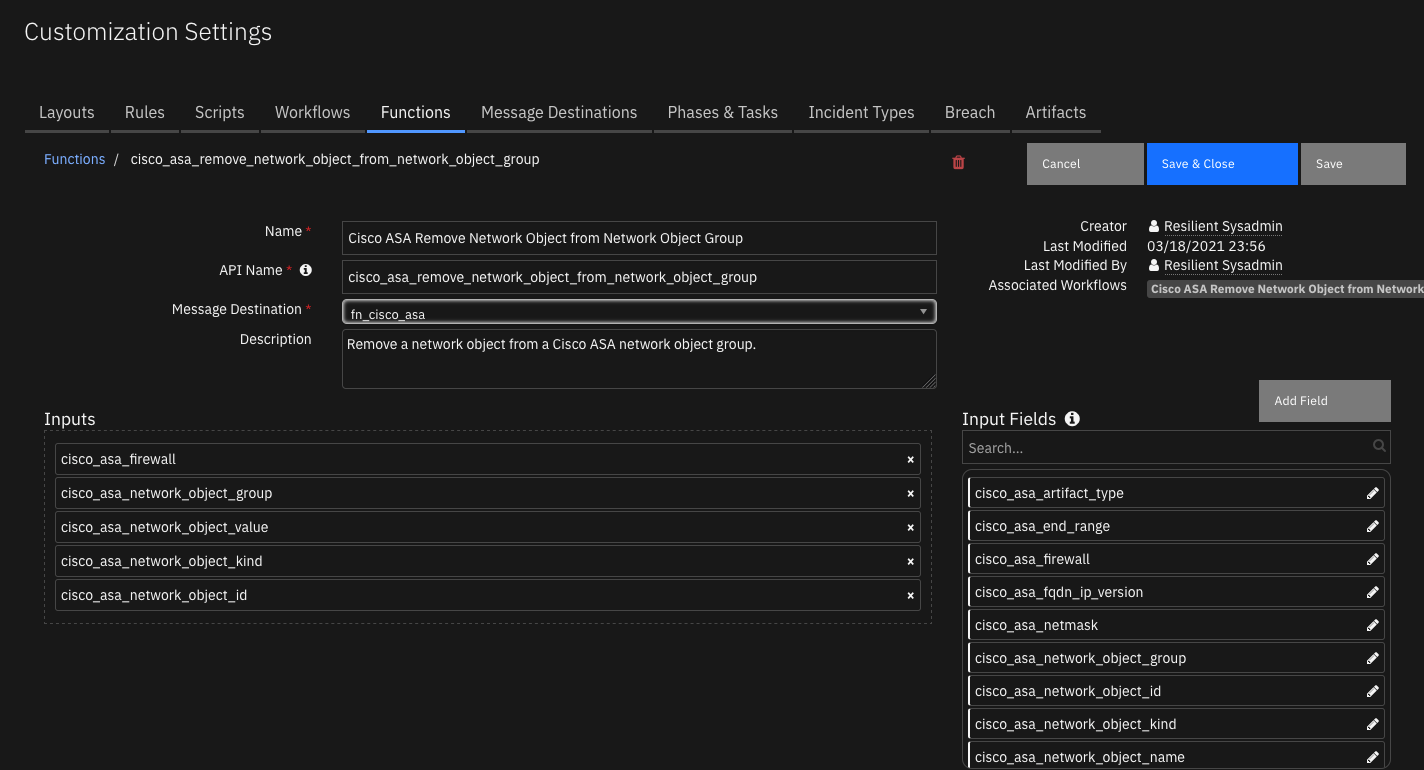
Inputs:
Name |
Type |
Required |
Example |
Tooltip |
|---|---|---|---|---|
|
|
Yes |
|
- |
|
|
Yes |
|
- |
|
|
No |
|
- |
|
|
Yes |
|
- |
|
|
Yes |
|
- |
Outputs:
NOTE: This example might be in JSON format, but
resultsis a Python Dictionary on the SOAR platform.
results = {
"content": "Object Kind: IPv4Address, Object Value: 192.168.10.1, Object Name: None, is removed from Firewall: firewall_1, Group: BLOCKLIST_IN",
"inputs": {
"cisco_asa_firewall": "firewall_1",
"cisco_asa_network_object_group": "BLOCKLIST_IN",
"cisco_asa_network_object_id": null,
"cisco_asa_network_object_kind": "IPv4Address",
"cisco_asa_network_object_value": "192.168.10.1"
},
"metrics": {
"execution_time_ms": 512,
"host": "MacBook-Pro.local",
"package": "fn-cisco-asa",
"package_version": "1.0.0",
"timestamp": "2022-06-24 12:24:30",
"version": "1.0"
},
"raw": "\"Object Kind: IPv4Address, Object Value: 192.168.10.1, Object Name: None, is removed from Firewall: firewall_1, Group: BLOCKLIST_IN\"",
"reason": null,
"success": true,
"version": "1.0"
}
Example Function Input Script:
inputs.cisco_asa_firewall = row.cisco_asa_firewall
inputs.cisco_asa_network_object_group = row.cisco_asa_network_object_group
inputs.cisco_asa_network_object_kind = row.cisco_asa_network_object_kind
inputs.cisco_asa_network_object_value = row.cisco_asa_network_object_value
inputs.cisco_asa_network_object_id = row.cisco_asa_network_object_id
Example Function Post Process Script:
from datetime import datetime
results = playbook.functions.results.remove_results
if results.success:
text = "Removed"
else:
text = "NotFound"
note = "Remove Network Object From Network Object Group Results:\n\n {0}".format(results.content)
incident.addNote(helper.createPlainText(note))
status_text = u"""<p style= "color:{color}">{status}</p>""".format(color="red", status=text)
row['cisco_asa_status'] = helper.createRichText(status_text)
row["cisco_asa_query_date"] = datetime.now()
Script - Cisco ASA: Write Artifact to Network Object data table¶
Write the network object to the Network Object data table or write an incident note if there was an error.
Object: artifact
Script Text:
from datetime import datetime
results = playbook.functions.results.add_artifact_results
success = results.get("success")
content = results.get("content")
firewall = content.get("firewall")
network_object_group = content.get("network_object_group")
network_object_value = content.get("network_object_value")
network_object_name = content.get("network_object_name")
network_object_kind = content.get("network_object_kind")
if success:
network_object_description = content.get("network_object_description")
# Add network object as a row in the network Cisco ASA network objects data table
network_object_row = incident.addRow("cisco_asa_network_object_dt")
network_object_row.cisco_asa_query_date = datetime.now()
network_object_row.cisco_asa_firewall = firewall
network_object_row.cisco_asa_network_object_group = network_object_group
network_object_row.cisco_asa_network_object_kind = network_object_kind
network_object_row.cisco_asa_network_object_value = network_object_value
network_object_row.cisco_asa_network_object_id = network_object_name
network_object_row.cisco_asa_network_object_description = network_object_description
# Update status field
status_text = u"""<p style= "color:{color}">{status}</p>""".format(color="green", status="Active")
network_object_row.cisco_asa_status = helper.createRichText(status_text)
else:
# Artifact not added to the group so add a note with the reason.
reason = content.get("reason")
note = u"Cisco ASA Add Artifact to Network Object Group Results:\n Artifact value: {0}\n Object Name: {1} \n Object Kind: {2} was not added to Firewall: {3}, Network Object Group: {4}\n\n{5}"
note = note.format(network_object_value, network_object_name, network_object_kind, firewall, network_object_group, reason)
incident.addNote(helper.createPlainText(note))
Script - Convert JSON to rich text v1.3¶
This script converts a json object into a hierarchical display of rich text and adds the rich text to an incident’s rich text (custom) field or an incident note. A workflow property is used to share the json to convert and identify parameters used on how to perform the conversion. Typically, a function will create workflow property and this script will run after that function to perform the conversion.
Features:
Display the hierarchical nature of json, presenting the json keys (sorted if specified) as bold labels
Provide links to found URLs
Create either an incident note or add results to an incident (custom) rich text field.
Object: incident
Script Text:
# (c) Copyright IBM Corp. 2010, 2022. All Rights Reserved.
VERSION = 1.3
"""
This script converts a json object into a hierarchical display of rich text and adds the rich text to an incident's rich text (custom) field or an incident note.
A workflow property is used to define the json to convert and identify parameters used on how to perform the conversion.
Typically, a function will create workflow property and this script will run after that function to perform the conversion.
Features:
* Display the hierarchical nature of json, presenting the json keys as bold labels
* Provide links to found URLs
* Create either an incident note or add results to an incident (custom) rich text field.
In order to use this script, define a workflow property called: convert_json_to_rich_text, to define the json and parameters to use for the conversion.
Workflow properties can be added using a command similar to this:
workflow.addProperty('convert_json_to_rich_text', {
"version": 1.3,
"header": "Artifact scan results for: {}".format(artifact.value),
"padding": 10,
"separator": u"<br />",
"sort": True,
"json": results.content,
"json_omit_list": ["omit"],
"incident_field": None
})
Format of workflow.property.convert_json_to_rich_text:
{
"version": 1.3, [this is for future compatibility]
"header": str, [header line to add to converted json produced or None. Ex: Results from scanning artifact: xxx. The header may contain rich text tags]
"padding": 10, [padding for nested json elements, or defaults to 10]
"separator": u"<br />"|list such as ['<span>','</span>'], [html separator between json keys and lists or defaults to html break: '<br />'.
If a list, then the data is brackets by the pair specified]
"sort": True|False, [sort the json keys at each level when displayed]
"json": json, [required json to convert]
"json_omit_list": [list of json keys to exclude or None]
"incident_field": "<incident_field>" [indicates a builtin rich text incident field, such as 'description'
or a custom rich text field in the format: 'properties.<field>'. default: create an incident note]
}
For playbooks, use playbook.addProperty() with the same format as workflow.addProperty()
Playbooks can also use playbook.functions.results.convert_json_to_rich_text using the standard function output which contains the 'content' json element.
When using playbook.functions.results.convert_json_to_rich_text with standard function results, all the defaults for padding, separator, etc. are used.
"""
import re
# needed for python 3
try:
unicode("abc") # fails in py3
py2 = True
except:
unicode = str
py2 = False
rc = re.compile(r'http[s]?://(?:[a-zA-Z]|[0-9]|[$-_@.&+#\?]|[!*\(\),]|(?:%[0-9a-fA-F][0-9a-fA-F]))+')
class ConvertJson:
"""Class to hold the conversion parameters and perform the conversion"""
def __init__(self, omit_keys=[], padding=10, separator=u"<br />", sort_keys=False):
self.omit_keys = omit_keys
self.padding = padding
self.separator = separator
self.sort_keys = sort_keys
def format_link(self, item):
"""[summary]
Find embedded urls (http(s)) and add html anchor tags to display as links
Args:
item ([string])
Returns:
[str]: None|original text if no links|text with html links
"""
formatted_item = item
if py2:
num_type = bool(item and isinstance(item, (int, long, bool, float)))
else:
num_type = bool(item and isinstance(item, (int, bool, float)))
if item and not num_type:
list = rc.findall(item)
if list:
for link in list:
formatted_item = formatted_item.replace(link, u"<a target='blank' href='{0}'>{0}</a>".format(link))
return formatted_item
def expand_list(self, list_value, is_list=False):
"""[summary]
convert items to html, adding indents to nested dictionaries.
Args:
list_value ([dict|list]): json element
Returns:
[str]: html converted code
"""
if not isinstance(list_value, list):
return self.format_link(list_value)
elif not list_value:
return u"None<br>"
try:
items_list = [] # this will ensure list starts on second line of key label
for item in list_value:
if isinstance(item, dict):
result = self.convert_json_to_rich_text(item)
if is_list:
items_list.append(u"<li>{}</li>".format(result))
else:
items_list.append(result)
elif isinstance(item, list):
items_list.append(self.expand_list(item, is_list=True))
elif is_list:
items_list.append(u"<li>{}</li>".format(self.format_link(unicode(item))))
else:
items_list.append(self.format_link(unicode(item)))
expand_list_result = self.add_separator(self.separator if not is_list else u"",
items_list,
is_list=is_list)
if is_list:
return u"<ul>{}</ul>".format(expand_list_result)
else:
return u"<div style='padding:5px'>{}</div>".format(expand_list_result)
except Exception as err:
return str(err)
def convert_json_to_rich_text(self, sub_dict):
"""[summary]
Walk dictionary tree and convert to html for better display
Args:
sub_dict ([type]): [description]
Returns:
[type]: [description]
"""
notes = []
if sub_dict and isinstance(sub_dict, (list, dict)):
if isinstance(sub_dict, list):
expanded_list = self.expand_list(sub_dict, is_list=True)
notes.append(self.add_separator(self.separator, expanded_list))
else:
keys = sorted (sub_dict.keys()) if self.sort_keys else sub_dict.keys()
for key in keys:
if key not in self.omit_keys:
value = sub_dict[key]
is_list = isinstance(value, list)
item_list = [u"<strong>{0}</strong>: ".format(key)]
if isinstance(value, dict):
convert_result = self.convert_json_to_rich_text(value)
if convert_result:
item_list.append(u"<div style='padding:{}px'>{}</div>".format(self.padding, convert_result))
else:
item_list.append(u"None<br>")
else:
item_list.append(self.expand_list(value, is_list=is_list))
notes.append(self.add_separator(self.separator, u"".join(make_unicode(v) for v in item_list), is_list=is_list))
result_notes = u"".join(notes)
if isinstance(self.separator, list):
return result_notes
else:
return result_notes.replace(
u"</div>{0}".format(self.separator), u"</div>").replace(
u"{0}</div>".format(self.separator), u"</div>"
) # tighten up result
def add_separator(self, separator, items, is_list=False):
"""
apply the separator to the data
:param separator: None, str or list such as ['<span>', '</span>']
:param items: str or list to add separator
:return: text with separator applied
"""
_items = items
if not _items:
return "<br>"
if not isinstance(_items, list):
_items = [_items]
if isinstance(separator, list):
return u"".join([u"{}{}{}".format(separator[0], item, separator[1]) for item in _items])
return u"{}{}".format(separator.join(_items), separator if not is_list else u"")
def make_unicode(value):
if value is None:
return 'None'
return unicode(value)
def get_results(property_name):
if playbook and playbook.functions.results[property_name] is not None:
return playbook.functions.results[property_name]
elif playbook and playbook.properties[property_name] is not None:
return playbook.properties[property_name]
elif workflow and workflow.properties[property_name] is not None:
return workflow.properties[property_name]
return None
def get_properties(property_name):
"""
Logic to collect the json and parameters from a workflow property.
Args:
property_name: workflow property to reference
Returns:
padding, separator, header, json_omit_list, incident_field, json, sort_keys
"""
result_properties = get_results(property_name)
if not result_properties:
helper.fail("Playbook/workflow property not found: {}".format(property_name))
padding = int(result_properties.get("padding", 10))
separator = result_properties.get("separator", u"<br />")
if isinstance(separator, list) and len(separator) != 2:
helper.fail("list of separators should be specified as a pair such as ['<div>', '</div>']: {}".format(separator))
header = result_properties.get("header")
sort_keys = bool(result_properties.get("sort", False))
json_omit_list = result_properties.get("json_omit_list")
if not json_omit_list:
json_omit_list = []
incident_field = result_properties.get("incident_field")
# workflow formatted content is 'json'. Standard functions is 'content'
json = result_properties.get("json") if result_properties.get("json") else result_properties.get("content")
json_err = None
# is there an issue we need handle now?
if not json and \
result_properties.get("success") == False and result_properties.get("reason"):
json_err = result_properties.get("reason")
return padding, separator, header, json_omit_list, incident_field, json, json_err, sort_keys
## S T A R T
padding, separator, header, json_omit_list, incident_field, json, json_err, sort_keys = get_properties('convert_json_to_rich_text')
if json_err:
result = "Result error: {}".format(json_err)
else:
if header:
if isinstance(separator, list):
hdr = u"{0}{1}{2}".format(separator[0], header, separator[1])
else:
hdr = u"{0}{1}".format(header, separator)
else:
hdr = u""
convert = ConvertJson(omit_keys=json_omit_list, padding=padding, separator=separator, sort_keys=sort_keys)
converted_json = convert.convert_json_to_rich_text(json)
result = u"{}{}".format(hdr, converted_json if converted_json else "\nNone")
rich_text_note = helper.createRichText(result)
if incident_field:
incident[incident_field] = rich_text_note
else:
incident.addNote(rich_text_note)
Data Table - Cisco ASA Network Objects¶
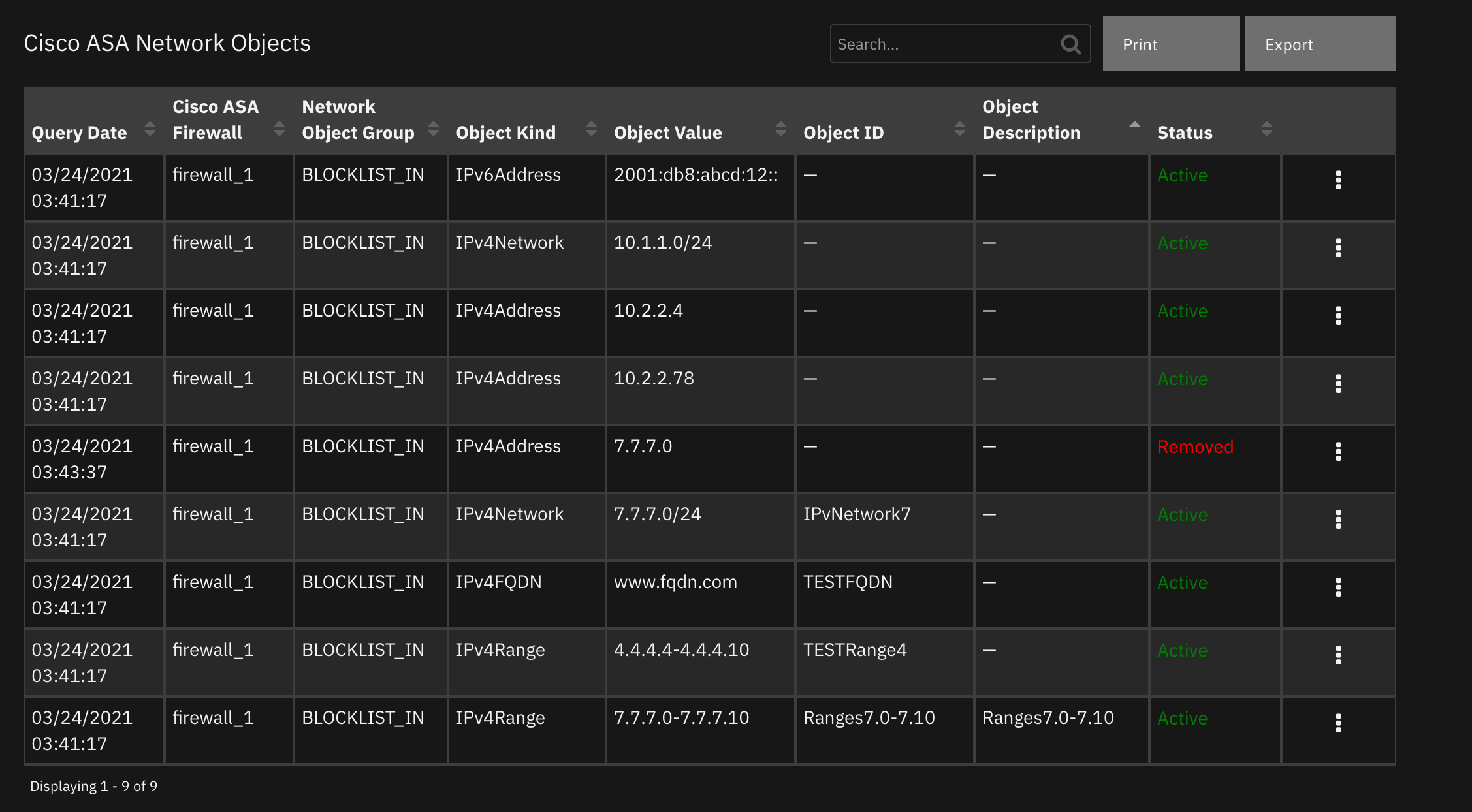
API Name:¶
cisco_asa_network_object_dt
Columns:¶
Column Name |
API Access Name |
Type |
Tooltip |
|---|---|---|---|
Cisco ASA Firewall |
|
|
- |
Network Object Group |
|
|
- |
Object Description |
|
|
- |
Object ID |
|
|
- |
Object Kind |
|
|
- |
Object Value |
|
|
- |
Query Date |
|
|
- |
Status |
|
|
- |
Playbooks¶
Playbook Name |
Description |
Activation Type |
Object |
Status |
Condition |
|---|---|---|---|---|---|
Cisco ASA: Add FQDN to Network Object Group (PB) |
Add an DNS artifact to a Cisco ASA network object group. If the artifact is not added to the group an error message is written to an incident note. |
Manual |
artifact |
|
|
Cisco ASA: Add IP Address to Network Object Group (PB) |
Add IP address artifact to Cisco ASA network object group. If the artifact is not added to the group an error message is written to an incident note. |
Manual |
artifact |
|
|
Cisco ASA: Add IP Range to Network Object Group (PB) |
Add IP range to a Cisco ASA network object group. If there is an error write it to an incident note. |
Manual |
artifact |
|
|
Cisco ASA: Add IPv4Network to Network Object Group (PB) |
Add an IPv4 network to a Cisco ASA network object group. If there is an error write the error to an incident note. |
Manual |
artifact |
|
|
Cisco ASA: Add IPv6Network to Network Object Group (PB) |
Add in IPv6 IP network to a Cisco ASA network object group. If an error occurs write it to an incident note. |
Manual |
artifact |
|
|
Cisco ASA: Get Network Object Details (PB) |
None |
Manual |
cisco_asa_network_object_dt |
|
|
Cisco ASA: Get Network Object Group (PB) |
Get the network objects of the specified network object group and write them to the Cisco ASA Network Objects data table. |
Manual |
incident |
|
|
Cisco ASA: Remove Network Object from Network Object Group (PB) |
Remove the network object from the specified Cisco ASA network object group. The status column of the row is marked as Removed in the data table. |
Manual |
cisco_asa_network_object_dt |
|
|
Troubleshooting & Support¶
Refer to the documentation listed in the Requirements section for troubleshooting information.
For Support¶
This is a IBM Community provided App. Please search the Community ibm.biz/soarcommunity for assistance.